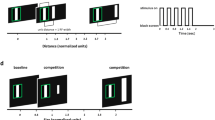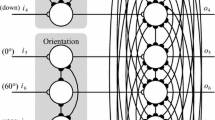Abstract
Behavioral experiments show that toads exhibit stimulus- and locus-specific habituation. Different worm-like stimuli that toads can discriminate at a certain visual location form a dishabituation hierarchy. What is the neural mechanism which underlies these behaviors? This paper proposes that the toad discriminates visual objects based on temporal responses, and that discrimination is reflected in different average neuronal firing rates at some higher visual center, hypothetically anterior thalamus. This theory is developed through a large-scale neural simulation which includes retina, tectum and anterior thalamus. The neural model based on this theory predicts that retinal R2 cells play a primary role in the discrimination via tectal small pear cells (SP) and R3 cells refine the feature analysis by inhibition. The simulation demonstrates that the retinal response to the trailing edge of a stimulus is as crucial for pattern discrimination as the response to the leading edge. The new dishabituation hierarchies predicted by this model by reversing contrast and shrinking stimulus size need to be tested experimentally.
Similar content being viewed by others
References
An der Heiden U, Roth G (1987) Mathematical model and simulation of retina and tectum opticum of lower vertebrates. Acta Biotheor. 36:179–212
Betts B (1989) The T5 base modulator hypothesis: a dynamic model of T5 neuron function in toads. In: Ewert JP, Arbib MA (eds) Visuomotor coordination: amphibians, comparisons, models, and robots. Plenum Press, New York, pp 269–307
Cervantes-Perez F, Lara R, Arbib MA (1985) A neural model of interactions subserving prey-predator discrimination and size preference in anuran amphibians. J Theor Biol 113:117–152
Eikmanns KH (1955) Verhaltensphysiologische Untersuchungen über den Beutefang und das Bewegungssehen der Erdkröte (Bufo bufo) L.. Z Tierpsychol 12:229–253
Ewert JP (1976) The visual system of the toad: behavioral and physiological studies on a pattern recognition system. In: Fite K (ed) The amphibian visual system: a multidisciplinary approach. Academic Press, New York, pp 141–202
Ewert JP (1984) Tectal mechanisms that underlie prey-catching and avoidance behaviors in toads. In: Vanegas H (eds) Comparative neurology of the optic tectum. Plenum Press, New York London, pp 246–416
Ewert JP (1987a) Neuroethology: toward a functional analysis of stimulus-response mediating and modulating neural circuitries. In: Ellen P, Thinus-Blonc C (eds) Cognitive processes and spatial orientation in animal and man, part 1. Nijhoff, Dordrecht, pp 177–200
Ewert JP (1987b) Neuroethology of releasing mechanism: prey-catching in toads. Behav Brain Sci 10:337–405
Ewert JP, Hock FJ (1972) Movement sensitive neurons in the toad's retina. Exp Brain Res 16:41–59
Ewert JP, Ingle D (1971) Excitatory effects following habituation of prey-catching activity in frogs and toads. J Comp Physiol Psychol 77:369–374
Ewert JP, Kehl W (1978) Configurational prey-selection by individual experience in the toad Bufo bufo. J Comp Physiol 126:105–114
Ewert JP, Seelen WV (1974) Neurobiologie und System-Theorie eines visuellen Mustererkennungsmechanismus bei Kröten. Kybernetik 14:167–183
Ewert JP, Burghagen H, Schürg-Pfeiffer E (1983) Neuroethological analysis of the innate releasing mechanism for prey-catching behavior in toads. In: Ewert JP, Capranica RR, Ingle D (eds) Advances in vertebrate neuroethology. Plenum Press, New York London, pp 413–475
Gross CG, Desimone R, Albright TO, Schwartz EL (1985) Inferior temporal cortex and pattern recognition. In: Chagas C, Gattass R, Gross C (eds) Pattern recognition mechanisms. Springer, Berlin Heidelberg New York, pp 179–201
Grüsser OJ, Grüsser-Cornehls U (1970) Die Neurophysiologie visuell gesteuerter Verhaltensweisen bei Anuren. Verh Dtsch Zool Ges 64:201–218
Grüsser OJ, Grüsser-Cornehls U (1976) Neurophysiology of the anuran visual system. In: Llinas R, Precht W (eds) Frog neurobiology. Springer, Berlin Heidelberg New York, pp 297–385
Ingle D (1980) The frog's detection of stationary objects following lesions of the pretectum. Behav Brain Res 1:139–163
Kandel E (1976) Cellular basis of behavior: an introduction to behavioral neurobiology. Freeman, New York
Kuffler SW (1953) Discharge patterns and functional organization of mammalian retina. J Neurophysiol 16:37–68
Lara R, Arbib MA (1985) A model of the neural mechanisms responsible for pattern recognition and stimulus specific habituation in toads. Biol Cybern 51:223–237
Lara R, Arbib MA, Cromarty AS (1982) The role of the tectal column in facilitation of amphibian prey-catching behavior: a neural model. J Neurosci 2:521–530
Lázár Gy, Toth P, Csink Gy, Kicliter E (1983) Morphology and location of tectal projection neuron in frogs: a study with HRP and Cobalt-filling. J Comp Neurol 215:108–120
Neary TJ, Northcutt R (1983) Nuclear organization of the bullfrog diencephalon. J Comp Neurol 213:262–278
Scalia F, Colman DR (1975) Identification of telencephalic efferent thalamic nuclei associated with the visual system of the frog. Neuroscience (abstr) 1:65
Scalia F, Gregory K (1970) Retinofugal projections in the frog: location of the postsynaptic neurons. Brain Behav Evol 3:16–29
Schleidt W (1962) Die historische Entwicklung der Begriffe “angeborenes auslösendes Schema” und “angeborener Auslösemechanismus” in der Ethologie. Z Tierpsychol 19:697–722
Sokolov E (1975) Neuronal mechanisms of the orienting reflex. In: Sokolov E, Vinogradova O (eds) Neuronal mechanisms of the orienting reflex. Erlbaum Hillsdale, New York, pp 217–235
Székely G, Lázár G (1976) Cellular and synaptic architecture of the optic tectum. In: Llinas R, Precht W (eds) Frog neurobiology. Springer, Berlin Heidelberg New York, pp 407–434
Teeters JL (1989) A simulation system for neural networks and model for the anuran retina. Technical Report 89–01, Center for Neural Engineering, University of Southern California, Los Angeles
Teeters JL, Arbib MA (1990) A model of anuran retina relating interneurons to ganglion cell responses. Biol Cybern 64:197–207
Tsai HJ, Ewert JP (1987) Edge preference of retinal and tectal neurons in common toads (Bufo bufo) in response to worm-like moving stripes: the question of behaviorally relevant “position indicators”. J Comp Physiol A 161:295–304
Thompson RF, Spencer WA (1966) Habituation: A model phenomenon for the study of neuronal substrates of behavior. Psychol Rev 73:16–43
Wilczynski W, Northcutt R (1983) Connections of the bullfrog striatum: afferent organization. J Comp Neurol 214:321–332
Author information
Authors and Affiliations
Additional information
The research described in this paper was supported in part by grant no. IRO1 NS 24926 from the National Institutes of Health (M.A.A., Principal Investigator)
Rights and permissions
About this article
Cite this article
Wang, D.L., Arbib, M.A. How does the toad's visual system discriminate different worm-like stimuli?. Biol. Cybern. 64, 251–261 (1991). https://doi.org/10.1007/BF00201986
Received:
Accepted:
Issue Date:
DOI: https://doi.org/10.1007/BF00201986




